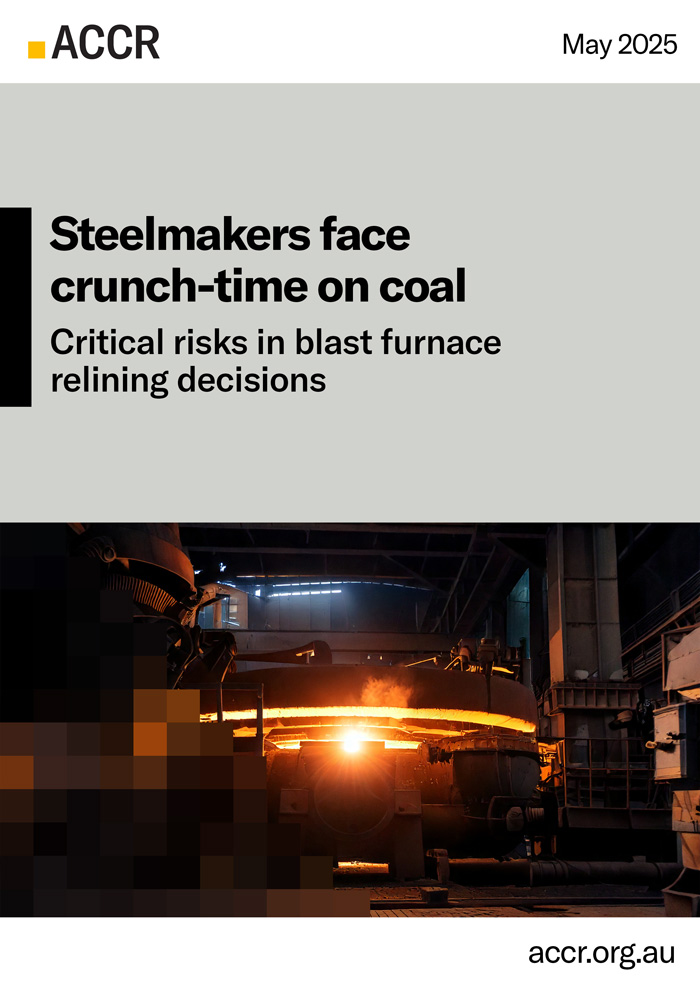Publication Steelmakers face crunch-time on coal: critical risks in blast furnace relining decisions
Executive Summary
Within the next decade, global steelmakers - particularly across Europe and key Asian markets[1] - face major capital expenditure (capex) decisions about the relining of coal-based blast furnaces. ACCR’s analysis of 13 major steelmakers - representing 17% of global steel production, or around 320 million tonnes per annum (Mtpa)[2] - shows that more than 60 coal-based blast furnaces require major relining decisions by the end of 2035. The implications for future carbon emissions are equivalent to the annual emissions of countries like Spain or Vietnam.
Steelmakers have a range of investment options available such as partial repairs, full relining, conversion to lower-emitting technologies, hot idling and permanent shutdown. The decisions made will have lasting implications for asset viability, emissions trajectories, and investor exposure to stranded assets and transition risk.
Investors have a limited but critical window for engagement with steelmakers on these decisions, yet many companies do not provide transparent and detailed disclosures on the status or timing of blast furnace plans. Without transparency on these inputs and associated costs, it becomes difficult for investors to assess whether companies are making strategic, future-fit investment decisions, or simply deferring transition risks.
As the steel sector approaches a decisive decade for blast furnace investment, investors have a critical role to play in ensuring capital is aligned with credible transition pathways. Strategic engagement now can help prevent emissions lock-in, reduce stranded asset risk and support a shift towards green production models.
Key Findings
The steel sector is responsible for 7-9% of global greenhouse gas (GHG) emissions, and the use of the coal-based blast furnace-basic oxygen furnace process (BF-BOF) in global steel production is responsible for just under 90% of the steel sector’s emissions.[3]
Our research identified that 62 blast furnaces (BF) from 13 steelmakers are due for a relining decision by the end of 2035.[4]
- More than 70% of relining decisions will occur between 2026 and 2035, providing a limited window for investors to influence capital allocation.
- Asia (48%) and Europe (37%) have the most BFs due for relining.
- Nearly all of Nippon Steel Corporation (73%) and JFE’s (71%) BF assets are due for relining before 2035, while 56% of U.S. Steel and 53% of ArcelorMittal's BF assets are due.
Based on the current global average emissions intensity of BF-BOF steelmaking (2.32 tonnes of CO2 per tonne of steel produced), the reline and continued operation of the 62 furnaces will potentially lock in up to 310 MtCO2/year[5] - equivalent to the annual emissions of countries like Spain or Vietnam.
This emissions intensity poses a direct challenge to meeting company-specific pathways towards global net zero by 2050, increases exposure to emerging carbon pricing mechanisms such as the EU’s Carbon Border Adjustment Mechanism (CBAM), and raises the risk of stranded assets for companies and investors.
BF relining typically costs around $300 million,[6],[7] but can cost up to nearly $1 billion,[8] with an average lifespan of 20 years.[9]
Alternative pathways to BF relining vary in technological readiness, emissions reduction potential and compatibility with different iron ore grades. Of the main options steelmakers are pursuing:
- Processes involving green hydrogen and direct reduced iron (H2-DRI) paired with electric arc furnaces (EAFs) offer the most immediate combination of significant emissions reductions and commercial readiness.
- Electrolysis is extremely promising but will not be commercially ready until around 2040.
- Traditional BF-BOF production, combined with carbon capture, utilisation and storage (CCUS), may offer some moderate emissions reductions, but faces significant cost, scalability and commercial readiness challenges.
When strategic engagement drives transparent, detailed disclosure from companies on their BF strategies, investors are better equipped to evaluate financial and emissions risks. In turn, this supports informed advocacy for effective capital allocation decisions and risk mitigation against emissions-intensive asset lock-in..
Download a PDF of Steelmakers face crunch-time on coal | 19/05/2025
Please read the terms and conditions attached to the use of this site.
This analysis excludes Chinese steelmakers due to limited publicly available disclosure on blast furnace assets. ↩︎
Based on 2023 company and global crude steel production data from the World Steel Association. ↩︎
Minerals Research Institute of Western Australia, 2023, Western Australia’s Green Steel Opportunity, p. 32, https://mriwa.sharepoint.com/sites/FinalReports/Shared Documents/Forms/AllItems.aspx?id=%2Fsites%2FFinalReports%2FShared Documents%2FFinal-Report_10471_MRIWA_M10471 - Full Report.pdf&parent=%2Fsites%2FFinalReports%2FShared Documents&p=true&ga=1 ↩︎
ACCR has assumed a standard operational lifespan (also referred to as a “campaign life”) of 20 years for each BF, based on the typical campaign lengths observed across the industry. See Appendix (“Methodology”) for further information. ↩︎
Using World Steel Association’s 2023 global average carbon intensity for BFs (2.32 tCO2/t steel). ↩︎
All $ values are US Dollars unless otherwise specified. ↩︎
Vogl, V., Olsson, O., & Nykvist, B., 2021, “Phasing out the blast furnace to meet global climate targets”, Joule, 5(10), 2646-2662, https://doi.org/10.1016/j.joule.2021.09.007 ↩︎
For example: Fernandez, T., 24 Jan 2025, ABC News, BlueScope Steel forges ahead with $1.15 billion blast furnace reline, https://www.abc.net.au/news/2025-01-24/bluescope-steel-pushes-ahead-with-blast-furnace-reline/104846320 ↩︎
Global Energy Monitor, July 2024, Pedal to the Metal 2024, p. 8, https://globalenergymonitor.org/wp-content/uploads/2024/07/GEM-Pedal-to-the-Metal-2024-steel-iron-report.pdf ↩︎
